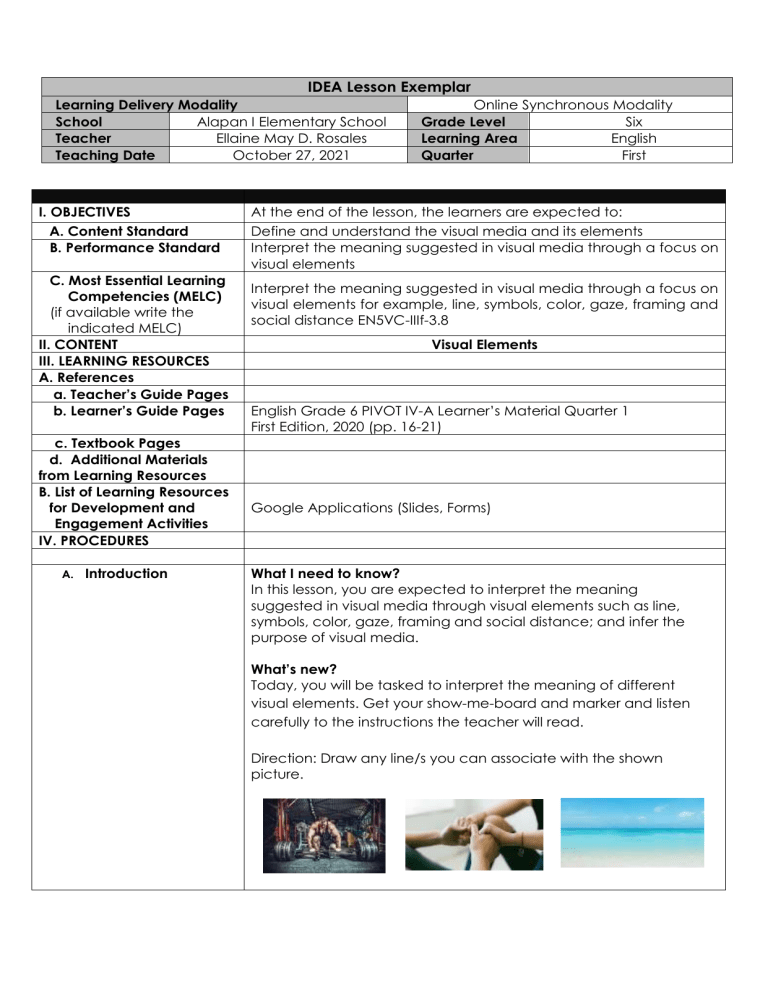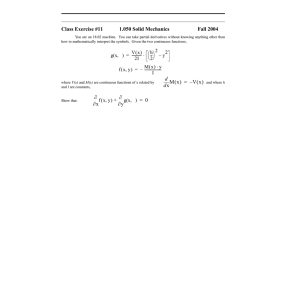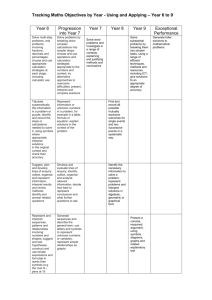
IDEA Lesson Exemplar Learning Delivery Modality School Alapan I Elementary School Teacher Ellaine May D. Rosales Teaching Date October 27, 2021 I. OBJECTIVES A. Content Standard B. Performance Standard C. Most Essential Learning Competencies (MELC) (if available write the indicated MELC) II. CONTENT III. LEARNING RESOURCES A. References a. Teacher’s Guide Pages b. Learner’s Guide Pages c. Textbook Pages d. Additional Materials from Learning Resources B. List of Learning Resources for Development and Engagement Activities IV. PROCEDURES A. Introduction Online Synchronous Modality Grade Level Six Learning Area English Quarter First At the end of the lesson, the learners are expected to: Define and understand the visual media and its elements Interpret the meaning suggested in visual media through a focus on visual elements Interpret the meaning suggested in visual media through a focus on visual elements for example, line, symbols, color, gaze, framing and social distance EN5VC-IIIf-3.8 Visual Elements English Grade 6 PIVOT IV-A Learner’s Material Quarter 1 First Edition, 2020 (pp. 16-21) Google Applications (Slides, Forms) What I need to know? In this lesson, you are expected to interpret the meaning suggested in visual media through visual elements such as line, symbols, color, gaze, framing and social distance; and infer the purpose of visual media. What’s new? Today, you will be tasked to interpret the meaning of different visual elements. Get your show-me-board and marker and listen carefully to the instructions the teacher will read. Direction: Draw any line/s you can associate with the shown picture. Guide Questions: 1. Why did you draw such line for picture #1? #2? Etc. 2. Did you associate any feelings or thoughts while drawing lines for each picture? 3. Can we say that every line has its own meaning? B. Development What is it? Visual media are symbols, pictures, icon, signs, and others that communicate with one’s sense of sight. Visual Media are materials, programs, and applications used to formulate information to aid learning using analysis, evaluation, and production of visual images. There are different types of visual media. Some of these are the: 1. Photos 2. Videos 3. Paintings 4. Graphic Organizers 5. Figures 6. Symbols What I know? Items put together to create visual resources for expressing and developing ideas in the image are what we call the elements of visual media. Visual elements are any characteristics that we can see including line, shape, direction, size, texture, color, and value. These visual elements help us interpret meaning from different visual media. Here are some of the elements of visual media: 1. Line - A line is a set of points extending in both directions. It is used to create shapes, forms, and textures. Lines can vary in direction, length, and width. They may be horizontal, vertical, diagonal, straight or curved. They can also be thick or thin. 2. Space - A line divides a space. This space is the area covered by the entire artwork. Space can be positive or negative. Understanding positive and negative space plays an important role in the composite of artwork. Positive space is the area of interest or the subject of the artwork. 3. Symbol - A symbol instantly makes people think of traits or message that they want to associate with a company, group, product or service. Through them, people find it easier to recognize, identify, or recall images than texts. The symbol represents the picture. It can be remembered and identified with greater ease than a thousand words describing a company. 4. Color - A color is very powerful. Looking at the colors can make us feel happy, calm excited. Every color has a psychological effect that a logo designer or photographer can use to his or her advantage. Color can create varied emotions. It is important to choose colors that best represent the character or identity of a company, organization, or service. 5. Gaze means to stare, suggests looking fixedly at something. To gaze is to look steadily and intently at something, especially at that which excites admiration, curiosity, or interest: to gaze at a scenery, at a scientific experiment. To stare is to gaze with eyes wide open, as from surprise, wonder, alarm, stupidity, or impertinence: to stare unbelievingly or rudely. 6. Framing - In visual arts and particularly cinematography, framing deals with the proper placement of the subject together with other images. This is a feature of visual elements to highlight the subject inside a particular frame. 7. Distance - Social distance is the distance between the viewer and subject. How close or far away is the subject shown? C. Engagement What’s more? You already know that in every image it uses visual elements for our brain to understand and interpret the meaning it suggests. Look at the pictures below. Identify what visual element is dominantly used in each picture. 1. 2. 4. 3. 5. Congratulations to all of you who got perfect scores, it won’t be impossible for you to perfect the quiz later! To those who did not get a perfect score, do not despair, the next activity will help you learn better about visual elements. What I can do? Group Activity: 1. After the teacher discussed the group tasks, go to Classroom, Classwork, then Group Task. 2. Open your Group Number then Group Task 2 Slides. 3. You will be given 10 minutes to do your task. 4. Once the time ends, everybody must stop working finish or not. 5. The leader will present the group’s work. Tasks: Group 1 - Each member will color the shape depending on his or her feeling today. Put your last name inside the shape. Group 2 - Make a collage of lines that you can associate with our situation amidst pandemic. Group 3 - Identify the subject being emphasized about the picture and make inferences out of it. Group 4 - Post symbols that you can associate with the word “Education”. Group 5 - Identify the emotions or thoughts portrayed in the given pictures. D. Assimilation What have I learned? Complete the statements by filling in the blanks with the correct word. V_____ M_____ are symbols, pictures, icon, signs, and others that communicate with one’s sense of sight. Some elements of visual media are L________, SP______, SY________, C________, F________, G__________, and D________. These V_____ E________S help us to IN____PR__T meaning from different visual media. What can I achieve? Open Google Classroom English and look for the QUIZ link. After answering, submit then click on View Accuracy to check your scores. Direction: Identify the visual element being described. 1. It means to stare, suggest looking fixedly at something, to look steadily and intently at something, especially at that which excites admiration, curiosity, or interest. 2. A set of points extending in both directions and used to create shapes, forms, and textures. 3. It instantly makes people think of traits or message that they want associated with company, group product or service. Through them, people find it easier to recognize, identify, or recall images than texts. 4. It refers to the "gap" between a viewer's conscious reality and the fictional reality presented in a work of art. 5. It deals with the proper placement of the subject together with other images. This is a feature of visual elements to highlight the subject inside a particular frame. 6.What visual element used in this image? 7. What meaning is suggested by the colors of this image? 8. What visual elements are used in this picture? 9. In this image, what type of line is mostly used? 10. What visual element is portrayed in this picture? V. REFLECTION Finish the statements below by writing about what you have learned today and your takeaway insights from the experience. Open Classwork, then Exit Ticket, and click on the attached Google Form. ● I understand that______________________ ● I realize that ______________________________ Prepared by: ELLAINE MAY D. ROSALES Teacher I Reviewed and Checked by: PENELOPE N. JARANGUE Master Teacher 1 Noted: DIVINA A. NARVAEZ Principal IV

